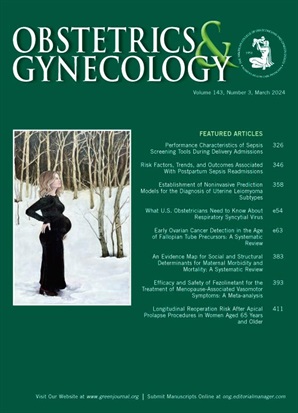多布斯诉杰克逊妇女健康组织案前后后期堕胎护理可获得性的变化。
IF 5.7
2区 医学
Q1 OBSTETRICS & GYNECOLOGY
引用次数: 0
摘要
目的研究自 2022 年美国最高法院在多布斯诉杰克逊妇女健康组织案的判决中终止对堕胎的联邦保护以来,程序性堕胎(尤其是在妊娠的第二和第三个三个月)可用性的变化情况。方法我们使用 "推进生殖健康新标准堕胎设施数据库"(一个包含所有公开宣传的堕胎设施的全国性数据库)来记录 2021 年至 2023 年期间服务可用性的趋势。我们计算了汇总统计数据,以描述美国以及各州、分区和地区的程序性人工流产设施妊娠限制,我们还检查了在妊娠的第二个或第三个三个月提供程序性人工流产的设施数量和比例。总体而言,2021 年提供程序性人工流产的机构中有四分之一(n=115)停止提供服务,另有 99 家降低了妊娠限制。相比之下,73 家机构提高了妊娠限制,64 家新机构开始提供或公开宣传程序性人工流产服务。提供妊娠晚期程序性人工流产服务的机构数量有所减少(提供妊娠 14 周或之后服务的机构从 327 家减少到 309 家,提供妊娠 24 周或之后服务的机构从 60 家减少到 50 家),但提供此类服务的机构在所有机构中所占的比例保持稳定。结论:自多布斯案判决以来,提供程序性流产服务的机构数量和分布大幅减少,提供晚期流产服务的机构也大幅减少。一些机构正通过开设新机构、公开宣传其服务或延长妊娠限制来满足患者的需求。本文章由计算机程序翻译,如有差异,请以英文原文为准。
Changes in Availability of Later Abortion Care Before and After Dobbs v. Jackson Women's Health Organization.
OBJECTIVE
To examine changes in availability of procedural abortion, especially in the second and third trimesters of pregnancy, since the U.S. Supreme Court ended federal protections for abortion in its Dobbs v. Jackson Women's Health Organization decision in 2022.
METHODS
We used the Advancing New Standards in Reproductive Health Abortion Facility Database, a national database of all publicly advertising abortion facilities, to document trends in service availability from 2021 to 2023. We calculated summary statistics to describe facility gestational limits for procedural abortion for the United States and by state, subregion, and region, and we examined the number and proportion of facilities that offer procedural abortion in the second or third trimester of pregnancy.
RESULTS
From 2021 to 2023, the total number of publicly advertising facilities providing procedural abortion decreased 11.0%, from 473 to 421. Overall, one-quarter of facilities (n=115) that had been providing procedural abortion in 2021 ceased providing services, and an additional 99 decreased their gestational limits. In contrast, 73 facilities increased their gestational limits, and 64 new facilities began providing or publicly advertising procedural abortion services. The number of facilities offering procedural abortion later in pregnancy decreased (327 to 309 providing 14 weeks of gestation or later, 60 to 50 providing 24 weeks of gestation or later), although the proportion of all facilities providing these services held steady. The greatest changes were in the South, where many facilities closed.
CONCLUSION
There have been substantial reductions in the number and distribution of facilities offering procedural abortion since the Dobbs decision, with critical decreases in the availability of later abortion services. Some facilities are positioning themselves to meet the needs of patients by opening new facilities, publicly advertising their services, or extending their gestational limits.
求助全文
通过发布文献求助,成功后即可免费获取论文全文。
去求助
来源期刊

Obstetrics and gynecology
医学-妇产科学
CiteScore
11.10
自引率
4.20%
发文量
867
审稿时长
1 months
期刊介绍:
"Obstetrics & Gynecology," affectionately known as "The Green Journal," is the official publication of the American College of Obstetricians and Gynecologists (ACOG). Since its inception in 1953, the journal has been dedicated to advancing the clinical practice of obstetrics and gynecology, as well as related fields. The journal's mission is to promote excellence in these areas by publishing a diverse range of articles that cover translational and clinical topics.
"Obstetrics & Gynecology" provides a platform for the dissemination of evidence-based research, clinical guidelines, and expert opinions that are essential for the continuous improvement of women's health care. The journal's content is designed to inform and educate obstetricians, gynecologists, and other healthcare professionals, ensuring that they stay abreast of the latest developments and best practices in their field.
 求助内容:
求助内容: 应助结果提醒方式:
应助结果提醒方式:


